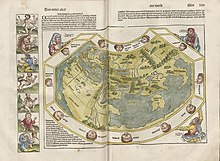Table of Nations (Bible)

A table of people is a compilation of the descendants of Noah in the tenth chapter of the first book of Moses (Genesis) in the Old Testament of the Bible ( Gen 10 EU ).
A similar compilation can be found in the Bible again in the first chapters of the 1st book of the Chronicle ( 1 Chr EU ). The origin of the tablet is in the 5th or 6th century BC. Dated to the 4th century BC, the authors may also have considered older material. Instead of.
According to the biblical idea, the three sons of Noah , Shem , Ham and Jafet , branched off from the people who were to inhabit the earth again after the destruction of mankind in the Flood . This is based on the idea common in antiquity that an ethnic group can genealogically be traced back to the descent from a progenitor . Overall, the chapter lists - depending on the reading - between 70 and 72 names of the surrounding peoples known in biblical Israel.
The fact that the peoples of Shem descended from Israel to the east, those of Ham in the southwest, and those of Jafet in the northwest was in the period from the European Middle Ages to modern times and in all regions influenced by biblical tradition a common notion. On the cycling map from the Etymologiae of Isidore of Seville from the beginning of the 7th century, printed in 1472 by Guntherus Ziner , one recognizes the names of the three sons of Noah assigned to the continents Asia (Sem), Europe (Jafet) and Africa (Ham). Hartmann Schedel goes back to Isidor in his Weltchronik (1493) when he depicts the three sons of Noah on the edge of the world map as they look at the areas populated by their descendants. The Bible text itself does not provide this simple equation of the descendants of the three sons of Noah with the inhabitants of the three continents known at the time, insofar as z. B. The Canaanites , who lived in the later land of Israel (and thus in Asia) before the Israelites , are counted among the descendants of Ham.
In the Eurocentric linguistics and ethnology of the 19th century, names were borrowed from the table of nations of the Old Testament, and linguistic families were inferred from supposed ethnic affiliations. Only the collective term Semitic languages has kept from these theories (see also: Semites and anti-Semitism ); the concept of a Hamitic language family and the Hamit theory based on it is technically just as out of date as the Japhetite theory of Russian linguists.
literature
- August Knobel : The table of people from Genesis , ethnographic studies, Gießen 1850 ( digitized version from the Bavarian State Library , digitized version from Google Books )
- Note: Knobel's work is an example of the mid-19th century perspective.
Web links
- Markus Witte: Völkertafel. In: Michaela Bauks, Klaus Koenen, Stefan Alkier (Eds.): The Scientific Biblical Lexicon on the Internet (WiBiLex), Stuttgart 2006 ff.
Remarks
- ↑ Markus Witte: Völkertafel (2.3. Dating) , in: WiBiLex (article created 2011); accessed January 16, 2017.
